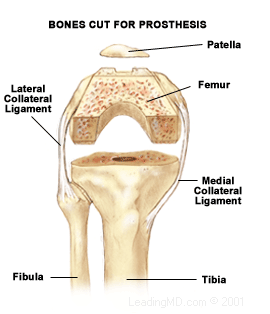
 Non-operativeTreatment
Non-operativeTreatment
Conservative treatment options are always tried first. These include:
- activity modification.
- exercise and conditioning.
- anti-inflamatory medication.
- Physical therapy programs in water (aquatic therapy) allow
patients to exercise in non-weightbearing situations.
- Shock-absorbing shoe inserts often relieve some pain during
activities.
- The injection into the joint of either cortisone
or newer visco supplements such as hyaluronic
acid may provide temporary relief for moderate to severe
conditions.
- neoprene sleeves and other dynamic braces to correct mal-alignment of the leg.
Operative Treatment
 Patients
having night pain, difficulty walking or performing normal activities
may be candidates for surgery. Operative treatments may include:
Patients
having night pain, difficulty walking or performing normal activities
may be candidates for surgery. Operative treatments may include:
-
arthroscopy and
debridement (removal) of loose chondral fragments
in the joint lining if the patient has symptoms such as pain
and swelling.
-
osteotomy, which
corrects the mal-alignment of the lower leg.
- Finally, knee replacement surgery may dramatically relieve the symptoms of knee arthritis.
Total knee replacement is an option for the patient who has not improved after trying the conservative measures described above and whose quality of life is severely affected. In knee replacement surgery all diseased cartilage is removed, and a metal and plastic prosthesis or replacement, is inserted. It is attached to the bone with bone cement or ingrowth of bone into the prothesis. The surgery takes one to two hours and requires a three to five day hospital stay. The results of knee replacement surgery are reliable, and over 95% of patients report good to excellent results at ten years.





